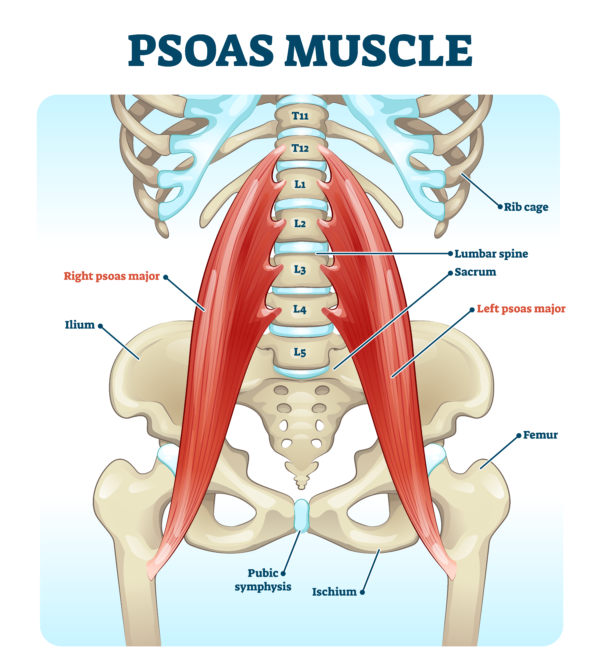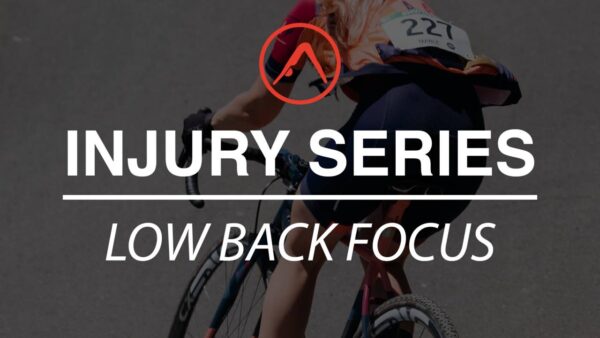Your primary hip flexor, psoas major, is a muscle that seems to have its hand in just about everything. When it comes to cycling, we are constantly putting it into a shortened position through contraction in the upstroke and our bent forward, flexed hip postures on the bike. This article will show why having a psoas stretch or two in your recovery toolbox might save you from countless days of lost riding due to tension, pain, and ache.
We’ll see later in this article how the psoas muscle is one of the main causes of lower back pain in cyclists. (Image credit: Beaunitta Van Wyk/Adobe Stock)
Sounds dramatic, doesn’t it? Well, the truth about this tissue is a tricky one, especially in our sport. When we say it has a hand in everything, we really mean it. It is (perhaps infamously) known as the stress muscle because of its proclivity towards holding tension as a result of stress and trauma in all areas of our lives.
For example, the psoas has an intimate relationship with the diaphragm, your primary respiratory (breathing) muscle. They cross over each other and share nerve innervations through similar vertebral segments of the spine. Dysfunction in one can cause problems in the other.
Cycling is unique in that there is a lot of cardiorespiratory stress, and also postural stress on the body because of how it has to move with the bicycle. A proper bike fit can certainly help, but there is simply no way around the fact that our hip flexors are going to get smashed as a result of too much biking.
Psoas Anatomy & Positioning on the Bike

(Image credit: VectorMine/Adobe Stock)
Our psoas is the only muscle that connects the upper and lower body. It attaches to all five of the lumbar (lower back) vertebrae, which is slightly troublesome (sarcasm) if you’re going to be chronically shortening it, as is the case with cyclists, but also just people in general with modern lifestyles that involve a lot of sitting at desks, on couches, and in cars.
The reason is because as the psoas shortens, it starts to pull on those lumbar vertebrae. This hyperextends the back into a position called lordosis, and consequently tilts the pelvis forward into a position called anterior pelvic tilt. Tightness in the hip flexor muscles also weaken their opposing muscles, the glutes (butt), in what is known as reciprocal inhibition.
Different pelvic positions. (Credit: sumaki/Adobe Stock)
Cycling exacerbates this process because of the positioning of our hips while riding. They are always in a somewhat flexed position, even at the end of our downstroke. This constant flexion is a recipe for psoas tightness, and is one of the reasons why cyclists are plagued with so much lower back pain.
Notice the position of this cyclist’s left hip. It is almost completely flexed, further exacerbated by her bent forward torso. (Image credit: Artem Varnitsin/Adobe Stock)
Benefits of Psoas Stretching for Cyclists
A testament to this muscle’s activity while we ride is that it has a bigger volume in more competitive cyclists, and grows even further with intense cycling training. By performing a variety of psoas stretches on off-days or even during and/or after your ride, it’s possible to mitigate the effects of psoas stiffness that will inevitably inhibit its function and wreak havoc throughout the rest of your body.
More than half of cyclists experience low back pain, and much of that can be attributed to dysfunction in the muscles surrounding the hip joint. Not only can a tight psoas pull on your lower back and anteriorly tilt your pelvis, but it can disrupt the timing and action of different muscles, causing some to overwork and others to become weak and underutilized.
As previously mentioned, there is a distinct relationship between the psoas and how you breathe because of its proximity to the diaphragm. Cyclist’s are already prone to faulty breathing patterns through their bent forward postures and the cardio demand of the sport. All the more reason to take care of our hips so they don’t contribute to what is often a cause of neck pain in cyclists.
Psoas Stretches
Below you’ll find some excellent hip flexor stretches that you can incorporate into your recovery routines, downtime, and even pre/during/post ride if you are experiencing low back pain as a suspected result of hip flexor tightness. Stretching before/during a ride can cause a subtle relaxing effect on the hyperactive hip flexor muscles, sometimes alleviating the pain that would otherwise arise.
Half Camel
Instructions:
- Start in a kneeling position with your knees, hips, and shoulders all stacked posturally on top of one another
- Place your hands on your hips or lower back
- Gently press forward and arch backwards, feeling a stretch in the abdominals and front of the hip
- Hold here for one minute
The psoas sits deep inside your abdomen, attaching to all the lumbar vertebrae. This stretch serves as a gentle opener to the hip and mid-section, and strives to reach into those internal fibers to help them release tension and relax. This is a great one to do in between periods of sitting.
Lifted Hip Flexor Stretch
Instructions:
- Rest one foot on top of a chair, focus on squaring your hips forward
- Keeping your chest tall, press the hips forward, extending your elevated leg behind you
- Hold for one minute
- Switch to the other leg
- Hold for one minute
This stretch allows you to go slightly deeper into the psoas muscle by keeping the torso erect and elevating the back leg. The elevation forces the hip to go into greater extension, which is the inverse function of the psoas and other hip flexor muscles.
Low Lunge Quad Stretch
Instructions:
- Start in a kneeling lunge position, both legs bent at 90°
- Squeeze your butt to tilt your pelvis backwards into a neutral position
- Engage your core at the same time to lock the position in place
- From here, gently stretch the back quad and hip muscles by pressing the hips forward
- Hold for one minute
- Switch to the other leg
- Hold for one minute
Your rectus femoris is a quadricep muscle that gets hammered while cycling. It has a dual function of knee extension and hip flexion, both repetitive movements in pedaling. Since they’re both hip flexors, by releasing the rectus femoris it helps the psoas to relax as well.
Get Rid of Cycling Back Pain!

Are you tired of suffering from back pain and discomfort while cycling? Look no further than Dynamic Cyclist. This comprehensive resource addresses the most common muscle imbalances and adaptive muscle shortening that lead to pain and reduced performance on the bike. With just 15 minutes a day, you can follow along with the video programs to alleviate tension and improve posture, so you can ride pain free and reach your full potential on the bike. Try out their 2 month Low Back Focus program and experience the results for yourself. Click here to try 7 days free!